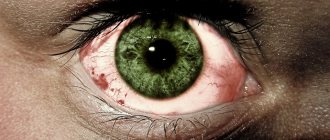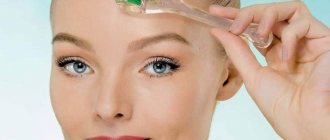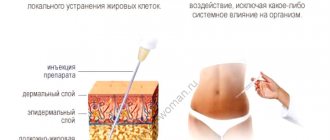What causes vitamin D deficiency?
Vitamin D deficiency in many Russian residents is due to:
- location in the northern temperate zone (above 42 degrees north latitude)
- limited exposure to the sun (office work, driving cars)
- eating meat from animals that have not been exposed to the sun (farm)
- use of sunscreens
- chronic diseases (obesity, intestinal pathology, taking a large number of medications)
You can determine the level of vitamin D in your body by taking the following test:
25-OH vitamin D (25-hydroxycalciferol) (amount)
Myth 3. All vitamins can be obtained from the “right” foods
What we eat is extremely important for the body, but it does not always fully cover its needs. The number of foods containing vitamin D is not at all as large as we would like - fatty fish, liver, beef. Agree, eating a lot of them all the time is quite problematic. Some nutritionists recommend eating dairy products containing whey protein once a day, but this is still a big question. So it’s quite reasonable to pay attention to dietary supplements.
For the curious
Vitamin D
combines a group of vitamins (D1, D2, D3, D4, D5), of which only two forms (D2 and D3) have important biological significance.
| 1. | 7DHC (cholesterol) | A precursor to vitamin D, it forms its reserve in the skin. |
| 2. | D3 (cholecalciferol) | In the skin 80% of vitamin D3 is formed from cholesterol under the influence of beta-UV rays. Its 20% enters the body with food of animal origin (fish oil, liver, egg yolk). |
| 3. | D2 (ergocalciferol) | Enters the body only with plant products (bread, etc.) |
| 4. | 25(OH)D3 (calcidol) | Then in the liver from both forms, as a result of hydroxylation (addition of an OH group), 25-OH-hydroxy-cholecalciferol (calcidol). This form is depot and transport; it is this form that is determined in the blood to determine the level of vitamin D. |
| 5. | 1.25(OH)D3 (calcitriol) | Next in the kidneys with the participation of parathyroid hormone (parathyroid hormone), the second hydroxylation occurs and the formation of the active form - 1,25-OH-dihydroxy-CHOLECALCIFEROL (calcitriol). It is calcitriol that provides the main biological effects of vitamin D in the body. |
The main biological role of calcitriol
(1,25-OH-vitamin D) is to maintain a constant level of calcium in the blood (vitamin D enhances the absorption of calcium in the intestines and, if there is not enough calcium in the blood, ensures the flow of calcium from the bones into the blood).
Over time, receptors for calcitriol, in addition to the intestines and bones, were found in the kidneys, genitals, pancreas, muscles, cells of the immune and nervous systems. Thus, it became clear that vitamin D performs a large number of different functions in the human body:
- regulates the expression of 3% of the human genome (several thousand genes)
- increases the sensitivity of the insulin receptor (prevention of insulin resistance, obesity, diabetes)
- strengthens the skeletal system
- reduces the level of parathyroid hormone in the blood
- promotes the synthesis of sex hormones (testosterone, estrogens, progesterone)
- improves reproductive function
- affects innate and acquired immunity
- prevents the development of tumors, depression, Parkinson's disease
08.02.2021 Who needs vitamin D and why?
Vitamin D deficiency is a very common problem in Russia. Vitamin D regulates the absorption of calcium and phosphorus minerals, their levels in the blood and their entry into bone tissue and teeth. Why this vitamin is needed, why it is lacking and what to do to make up for its deficiency, let's talk in this article. Vitamin D is called the "sunshine vitamin" because it is produced naturally in response to exposure to the sun's ultraviolet B (UVB) rays. Many people know that vitamin D is essential for healthy bone growth in children and adults. It also increases resistance to viral diseases. A lack of this vitamin can cause rickets in children, and softening of bones and an increased risk of fractures in adults. With a normal supply of this vitamin, most processes in the body improve. Why do we need vitamin D? This is one of the many vitamins our body needs to maintain health, and performs many functions, including: - maintaining bone strength, ensuring normal growth and development of bones, preventing the development of rickets and osteoporosis by regulating mineral metabolism; - promotes muscle tone, improves immunity, is necessary for the functioning of the thyroid gland and normal blood clotting; - Provides support to the nervous system. Sources of vitamin D The body receives this component in several ways: it is synthesized in the skin under the influence of ultraviolet radiation and comes from food. Provided that the body receives a sufficient amount of ultraviolet radiation, the need for vitamin D is fully compensated. However, vitamin D is synthesized by the body only if the sun's rays hit the skin at a certain angle, which is observed from 11 a.m. to 2 p.m. For children, this time may coincide with lunch or bedtime, while for adults it may be at work. Vitamin D Rich Foods
Fish oil - 250-350 mcg/100 g Cod liver - 100-200 mcg/100 g Pink salmon, salmon, mackerel, chum salmon, herring, trout, eel, halibut - 10-30 mcg/100 g Black caviar - 8 mcg/100 d Egg yolk - 7.7 mcg/100 g Goat milk - 1.3 mcg/100 g Butter - 1.5 mcg/100 g Hard cheeses - 1 mcg/100 g Often, vitamin D deficiency can be compensated for by taking medications. The dosage is determined by the doctor, based on a blood test to determine the actual level of the vitamin. Vitamin D is available to the consumer in several different forms. The most common are aqueous and oil solutions, as well as tablets. - Aqueous solution - the main advantage is rapid absorption. Vitamin D in this form is easily absorbed and immediately begins to work without disrupting digestive function. — Oil solution. The fat-soluble form of vitamin D3, physiological for the body, is one of the main advantages of the oil form. This form of the vitamin is recommended to be taken after meals, which is not always convenient. - Pills. Their undeniable advantages are dosage accuracy and ease of administration. The tablet can be taken at any time of the day or night, anywhere, even while driving a car. This form of vitamin D does not require additional conditions, such as food intake. Its only drawback is the lowest suction speed. What to take vitamin D3 with When taking any vitamins and minerals, you need to consider their compatibility with each other. Vitamin D absorption is helped by minerals such as magnesium, zinc, boron, calcium and phosphorus. It is worth remembering that vitamin D can accumulate in the body. And if you take medications uncontrollably, there is a risk of bringing the vitamin level to a state of hypervitaminosis, which is also bad. Important: before taking it, you should definitely consult your doctor.
Vitamin D deficiency
A lack of vitamin D in the body can lead to the development of:
- diseases of the cardiovascular system
- immunodeficiency, allergies, psoriasis, bronchial asthma, rheumatoid arthritis
- periodontal disease
- tumors of the large intestine, mammary glands, ovaries, prostate
- chronic fatigue, depression, insomnia
- decreased muscle strength leading to a risk of falls
- decreased motility and number of morphologically normal sperm (male factor infertility)
- risk factor for premature birth, fetopathies (less than 20 ng/ml)
Achieving a vitamin D level of 50 ng/ml (125 nmol/l) reduces the risk of developing:
| % | |
| Rakhita | 100 |
| Ostemalacia (softening of bone tissue) | 100 |
| Cancer in general | 75 |
| Breast cancer | 50 |
| Ovarian cancer | 25 |
| Colon cancer | 65 |
| Kidney cancer | 65 |
| Uterine cancer | 35 |
| Diabetes mellitus type 2 | 50 |
| Perelomov | 50 |
| Falls in women | 70 |
| Multiple sclerosis | 50 |
| Myocardial infarction | 50 |
| Vascular diseases | 80 |
| Preeclampsia | 50 |
| Caesarean section | 75 |
| Infertility | 70 |
Vitamin D is important during pregnancy.
Its deficiency is associated with the risk of developing gestational diabetes mellitus, premature birth, preeclampsia, and various intrauterine developmental defects.
There is not a single case of teratogenic (leading to the development of tumors) effect of vitamin D in the world.
Myth 5. Vitamin D is rarely found in cosmetics
Not at all. It is actively used in cosmetology. For example, in anti-aging skin products - creams, serums, lotions and even... lipsticks (though mostly hygienic ones). Not the entire group of vitamins D is used, but mainly only calciferol (D3), which is the active substance. Sometimes artificial forms of the substance are used. They are good because they enhance the effect of the vitamin, which is naturally produced by the body or taken in the form of foods or dietary supplements.
Vitamin D standards
Considering the different units of measurement, the recommended level is:
60 - 100 ng/ml
150 – 250 nmol/l
To convert from ng/ml to nmol/l you need ng/ml * 2.5 = nmol/l
Example: 30 ng/ml * 2.5 = 75 nmol/l
Russian Association of Endocrinologists
considers
the optimal concentration
of vitamin D in the blood of an adult to be 30-100 ng/ml,
deficiency is
20-30 ng/ml,
deficiency
is less than 20 ng/ml.
According to data presented at the 10th European Congress on Menopause and Andropause (Madrid, 2015), vitamin D levels in obese patients in Russia:
less than 20 ng/ml - 35%
20-30 ng/ml - 30%
more than 30 ng/ml - 35%
Daily Values for Vitamin D
according to the recommendation of the American Society of Endocrinology (2011).
| Age group | Recommended daily dose, IU | Maximum permissible level of consumption, IU |
| Infant, 0 - 6 months | 400 | 1000 |
| Infant, 7 - 12 months | 400 | 1500 |
| Children 1 - 3 years old | 600 | 2500 |
| Children 4 - 8 years old | 600 | 3000 |
| Children 9 - 17 years old | 600 | 4000 |
| Adults 18 – 70 years old | 600 | 4000 |
| Adults over 70 years old | 800 | 4000 |
| Pregnancy and lactation | 800 | 4000 |
Prophylactic dose
vitamin D (when you can not detect it in the blood and take it calmly) is considered to be 4,000 IU per day.
Without medical supervision, it is not recommended to take vitamin D at a dose of 10,000 IU for more than 6 months. (Russian Association of Endocrinologists)
It is almost impossible to overdose on vitamin D. For example, in Holland, an elderly couple (90 and 95 years old) accidentally took a single dose of cholecalciferol 2,000,000 IU each.
Doctors monitored them for 2 months and did not identify any symptoms of overdose or toxicity. The maximum blood concentration of its form of 25-OH-vitamin D on day 8 was 210 and 170 ng/ml, respectively, which is slightly higher than its target values.
Homemade face mask
Products containing calciferol can also be prepared at home. One of them is a mask that uses the following ingredients:
- chopped fresh parsley (100 g);
- vitamin D (1 capsule);
- a little sour cream.
Principle of preparation and use
Mix parsley with 1 capsule, sour cream, apply a thin layer to cleansed facial skin. Leave for 10-15 minutes and rinse with water.
Course – 1-2 months. Frequency – 1-2 times a week.
Criticism
The wave of publications about the healing properties of vitamin D in medical, semi-medical, and completely non-medical publications began about 30 years ago and shows no sign of abating. If you type “vitamin D” next to the name of any disease in an Internet search engine, you will find many articles about positive effects in treatment or the impact of vitamin D deficiency on the course of the disease. Here, for example, is a study showing that a lack of vitamin D can lead to a more severe course of coronavirus infection. But some experts do not agree with the absolute benefits of taking it.
“All statements about the direct effect of vitamin D on immunity, insulin and general well-being have nothing to do with evidence-based medicine,” says Vasily Vlasov, vice-president of the Society of Evidence-Based Medicine Specialists, Doctor of Medical Sciences. — There are no convincing, reproducible studies regarding the healing properties of calciferols in the prevention, much less treatment, of real diseases. Over the past two to three decades, there have been hundreds of articles about the successful use of vitamin D in the treatment of a variety of diseases: from baldness and impotence to strokes and hypertension. All of them have not been verified by subsequent clinical trials. Therefore, when similar articles now appear annually, the attitude towards them is quite skeptical.”
Severe vitamin D deficiency is often observed in a variety of diseases, such as obesity and type 2 diabetes. But doctors look at restoring normal levels differently.
“The importance of vitamin D for the body is just a fashionable topic,” says Alexander Lavrishchev, a therapist at the Semeynaya clinic. Several years ago, vitamin E was fashionable among hepatologists, after a series of publications on this topic. If a doctor wanted to look progressive, he had to try large doses of vitamin E on the patient. 90% of the Russian population lives with vitamin D deficiency. It is easy and inexpensive to synthesize, and if there is a huge market, then there is a big business. As a medicine, vitamin D is unlikely to be effective: I know of no cases in which a patient with an unclear illness would recover only by replenishing the deficiency of this substance.”
Olga Shamrina, who has repeatedly seen exhausted patients with a noticeable vitamin D deficiency, who had previously seen many doctors who had not found any pathologies, does not entirely agree with her colleague.
“If a person has no complaints, this does not mean that there is no vitamin D deficiency,” says the doctor. - You may never notice him. It’s just that sometimes you will be more tired than usual, have difficulty waking up, and sometimes react more forcefully to changing weather. A married couple who had seen many doctors before came to see me by chance. A 45-year-old woman had been unable to get pregnant for more than 3 years and was planning to do IVF. Vitamin D analysis showed that both spouses had a pronounced deficiency. After a short course of treatment with only vitamin D, everything went well. Now the child is already one and a half years old.”
Admission rules
You should take the pharmacy vitamin strictly following the instructions, namely:
- The drug is taken in the morning or at lunch (first half of the day), since it can actively affect the nervous system and cause overexcitation and insomnia. This point especially applies to children.
- Since vitamin D is classified as a fat-soluble vitamin, you need to eat something fatty along with the pill. So he will assimilate well.
- Separate intake of vitamins D and E is indicated, since their combined use reduces the absorption of both.
- Calcium and another vitamin K are well absorbed along with vitamin D. It is not at all necessary that the intake take place at the same time, the body simply must receive a daily dose of all of the listed substances.
Why do people decide that they need to take vitamins?
Nitrogenous organic substances, amines, necessary for life, which are not produced in the body, were once called vitamins. They were studied and it was determined which enzyme in the cell each of them provides. Signs of a deficiency of a particular vitamin in the diet were formulated: if, with a deficiency of a substance, symptoms of a specific disease appear, and after replenishing the amount of the vitamin they disappear, the disease is caused by a deficiency and fortification is a direct treatment. This was the case, for example, with vitamin C, which cures scurvy.
In the mid-twentieth century, the range of vitamins expanded, and at the same time a new concept emerged: even if a minor deficiency does not cause symptoms, a generous supplement of a vitamin to the body can improve well-being and have a beneficial effect on associated ailments. Numerous attempts to treat any disease with horse doses of vitamin C have not taken root in clinical practice. Vitamin A in large doses turned out to be simply toxic to the body.
“D is the only vitamin that has an effect on the immune system, and this has been confirmed in many studies,” says GMS Clinic allergist-immunologist Olga Sidorovich. — It’s the only vitamin I personally take from October to March. The effect of other vitamins in preventing colds, including vitamin C, which is widely used for this purpose, has not been proven.”
Doctors view vitamin D favorably mainly because in northern latitudes the vast majority of the population cannot obtain the amount of vitamin considered normal, either through food or sunlight. In the autumn-winter period, vitamin D deficiency becomes especially acute. A deficiency is considered to be less than 30 ng/ml.
Which vitamin D should you choose? What is the difference between D2 and D3?
Vitamin D2 and are equivalent to each other. They have the same value for the body, and also have similarities in metabolic processes and therapeutic effects. However, their presence in the body is ensured in various ways. Thus, vitamin D3 is formed from a substance such as 7-dihydrocholesterol under the influence of sunlight. Vitamin D2 enters cells through the bloodstream through the passage of nutrients obtained from food through the stomach wall ().
If we talk about the difference between vitamins D2 and D3, it is worth comparing their bioavailability. The second of these compounds is called cholecalciferol. It can be produced by the body independently, so it is better absorbed from foods. Cells recognize it faster, due to which active biochemical processes begin, leading to the formation of calcitriol. This active formula of the substance promotes the effective absorption of calcium.
Vitamin D2 is called ergocalciferol. The rate of its conversion to calcitriol is slowed down, since the body needs more time to recognize the structure of the compound. As a result of the slow flow of biochemical processes, by-products are formed. If vitamin D2 is used in small doses, then toxic substances formed during its breakdown are quickly removed from the tissues. When using large dosages of the drug, breakdown products accumulate in the body, which can harm health.











